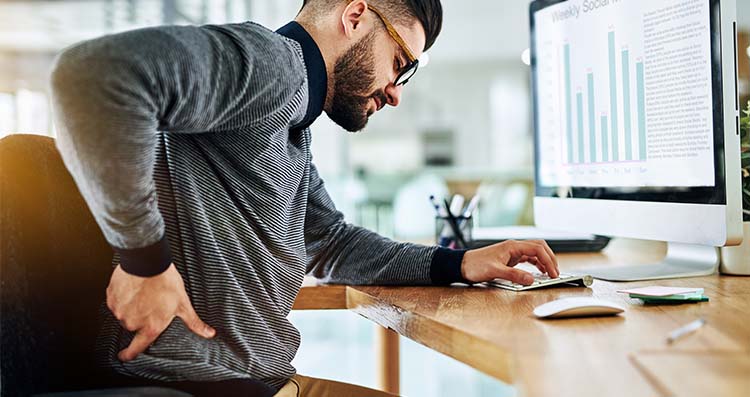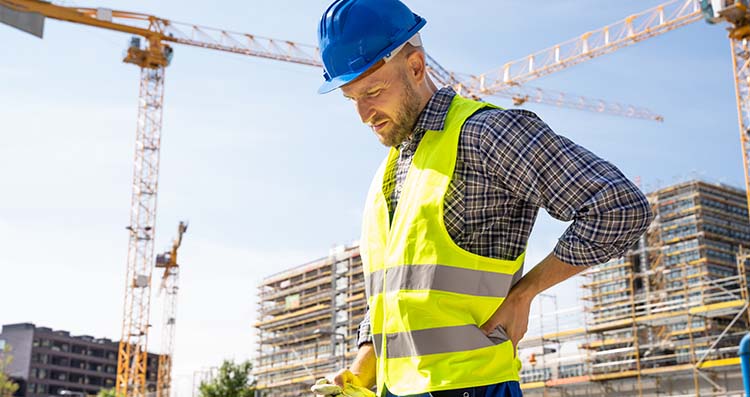Prio for ergo: working together towards reduced physical strain in the workplace
In 2023, 46% of workers were suffering from back pain - the leading cause of early retirement. Moreover, 30% of long-term absenteeism is linked to back and muscle problems. A new Royal Decree now ensures that employers must specifically focus their prevention policies on ergonomics. But beyond those new regulations, awareness and efforts remain essential - for employers and employees alike.
The Royal Decree (RD) for ergonomics at work and prevention of musculoskeletal disorders (MSDs) has been in force since 25 May 2024. Among other things, this obliges employers to consider ergonomic aspects when designing and adapting workplaces. They must review that policy every year using a risk analysis.
Sitting zombies
The Royal Decree has not just come out of the blue. “Humans are naturally inclined to conserve their energy and use it as efficiently as possible”, says Gerrit Pollentier, head of ergonomics at Mensura. Combined with technology, this has caused us to move less and less - and in a less varied way: sitting for long periods of time, typing constantly, etc. This means our bodies are getting weaker and weaker”.
But employees with a physical job do not necessarily have fewer complaints than sedentary screen workers (the so-called 'sitting zombies'). They too often move in an unnaturalway: repetitive actions on an assembly line, handling a vibrating jackhammer, moving patients in the healthcare sector, etc. “Most of the time, it is not about a specific movement or posture, but about its intensity and repetition, without alternation or rest”, says Dr. Marc Schiltz, head of Physical Medicine & Rehabilitation at UZ Brussel. “You find that in both sedentary and active professions.”
Exercise is of course healthy for the body. But when we ask more of our body than it can handle, we’re faced with a situation of overloading. This can eventually lead to injuries (back pain, muscle strain, aching joints, etc.) and even chronic conditions. The sooner we become aware of this overload, the better. The new RD envisages an important role for employers in this respect, but employees can also play their part.

Prevention: back to basics
“We still have a long way to go, even though the RD is a good start”, argues Gerrit. “Employers often give their employees the option to use sit-stand desks, for example, but in doing so they forget their job as role models: these tools only really work if managers set a good example. Employers are also easily seduced by new ergonomic gadgets, whereas it is best to look at the basics first: does your workplace invite healthy exercise behaviour?”
To help employers with this, Mensura's ergonomists use a three-step approach: explore the situation, discuss possible improvements with employee input, and discuss specific feasible proposals with the employer - supplemented or not by training.
Patterns and Pomodoro
In an ideal world, employers and employees would work together to minimise physical strain at work. In doing so, workers not only follow ergonomic principles in the workplace, but also outside it: listening to your body, taking enough breaks, getting regular varied exercise and following a healthy lifestyle in general. Mensura is also exploring plenty of self-help apps that allow workers to 'scan' their symptoms.
“But we need to be more alert first of all”, Marc advises. “If you start experiencing back pain, for example, look at where you experience it most: at your home workplace or in the office? By following that pattern, you know where to make adjustments.”
“Of course it is best to invest in an ergonomic workplace that invites healthy exercise behaviour”, Gerrit points out. “If this is not available, go for a creative solution. If necessary, put your laptop on a box, or on top of a chair on the table when you have meetings. But the most important thing is intermittent exercise. The Pomodoro technique is good for your body as well as your time management: 25 minutes working, 5 minutes walking around, 25 minutes working and so on.”
Rest rusts
Gerrit and Marc also want to clear up a persistent misunderstanding. Do you have (lower) back pain? Above all, do not lie flat, but keep moving to keep your body supple. “After a sprained ankle, most people try to get on their feet again as soon as possible”, Marc explains. “But with back pain, a kind of fear strikes: we are too afraid to move around any more to ’avoid making it worse’ - while that movement is just right for you. It's a message we need to keep repeating.”
The importance of awareness
The importance of prevention is further emphasised by another misunderstanding. In the past, back pain was often linked to a mechanical cause, but today we know that other factors also come into play.
“There is rarely one root cause with back pain”, Marc explains. “After all, a job can be stressful not only in terms of attitude, but also psychosocially. Do you experience a lot of stress? A high workload? And how long have you been feeling like that? You have to add up all those stress situations, and that combination sometimes makes diagnosis and treatment very complex.”
“Active prevention is therefore very much needed”, concludes Gerrit. “This is why we want to raise awareness among people - employers and employees - about the importance of self-care for their musculoskeletal health. We also provide specific tools to lower the threshold together. You could compare the whole process to a long car ride uphill. Did you acquire a 2CV for the ride? If so, the car will quickly backfire. Have you invested in a heavier engine? Then you will last much longer.”

Could your workplace use some ergonomic support?
If so, please feel free to contact us through the form below.